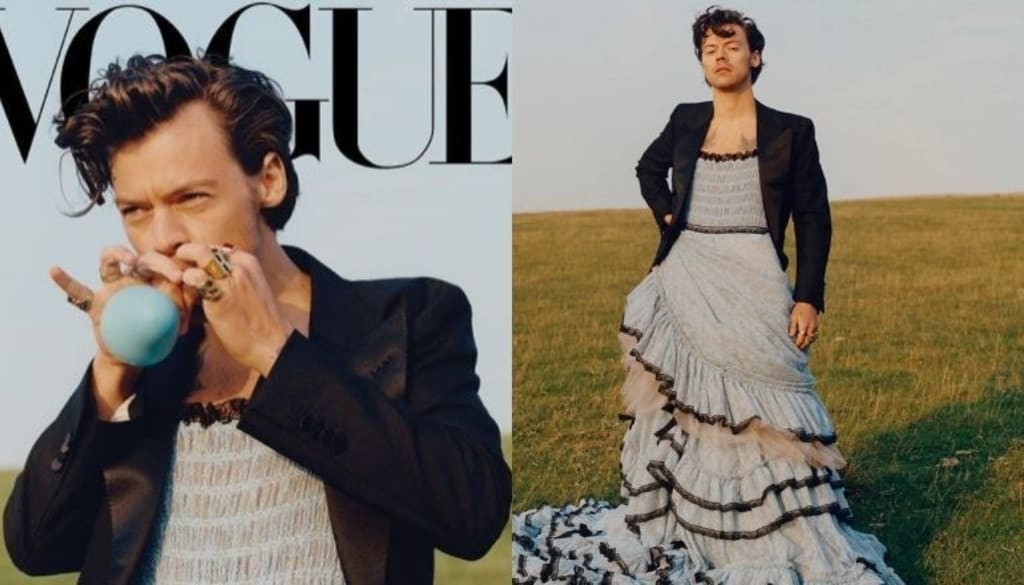How Harry Styles Subverted the Patriarchy by Wearing a Dress on the Cover of Vogue
Society is waging a covert war on femininity. Pop culture can fight back.

On November 13, 2020, Harry Styles appeared on the cover of Vogue Magazine wearing a dress.
It wasn’t an understated dress either, but rather one with frills and a low neckline. And this wasn’t the only picture in the spread where he donned feminine clothing. In four other portraits, Styles sported skirts. These feminine stylistic choices weren’t meant to make a political statement; rather, Styles notes that he just enjoys experimenting with fashion:
There’s so much joy to be had in playing with clothes. I’ve never thought too much about what it means—it just becomes this extended part of creating something.
The backlash against Styles’ choice to wear a dress was swift and aggressive. Candace Owens, a conservative political commentor, tweeted that the “feminization of our men… is an outright attack. Bring back manly men.”
The real attack, however, is not the feminization of men, but rather society’s villainization of the feminine. For over a century, women have been fighting for gender equality in this country—that is, equality between men and women when it comes to rights, education, and leadership positions. But despite the fact that women have made significant gains in this regard, little has changed in the relationship between masculinity and femininity. Femininity is still degraded, and masculinity revered. In fact, gender equality seems based on the idea that women will be accepted if they express themselves with more masculine qualities, thus completely abandoning their femininity to gain respect. Likewise, men also must express themselves with masculine characteristics to be taken seriously.
Tl;dr: Society is raging a covert war against femininity.
By masculinity, I mean qualities typically associated with men: strength, aggression, leadership, confidence, rationality, etc. Femininity, on the other hand, encompasses qualities typically associated with women: being emotional, physically weaker, dainty, fragile, nurturing, coy, shy, etc.
Please note—I am not saying that all men have masculine characteristics, and all women have feminine characteristics. In fact, I believe that everyone, regardless of their gender, has both masculine and feminine energy within them. Rather, I’m saying that the concepts of masculinity and femininity have specific characteristics that they’ve historically been associated with.
Over the course of the fight for gender equality, it’s always been the masculine qualities that are accepted. It’s fine for women to have gender equality as long as that means they will adopt more masculine characteristics. What is still not fine is for women to be equally valued for their feminine qualities—or even more, for men to be valued for these qualities.
Think about it. When women are valued, it’s because they’re strong, confident, or rational. It’s because they’re ‘a cool girl’ who can hang with the guys, or because they ‘aren’t a typical woman.’ For women to gain positions of power or be respected as leaders, it’s usually because they are disassociated with the feminine or even because they themselves deride characteristics of femininity. (Hello, Margaret Thatcher in the Crown).
While the famous Always commercial “Always #LikeAGirl” is a powerful and moving pop culture push for gender equality, it too applauds the qualities of traditional masculinity by solely featuring the strength of girls.
Girls can play sports just as well as boys can, the commercial puts forward. While this is true and important, it demonstrates how society values girls only when they express more masculine qualities. But why can’t there be a commercial that values girls for their feminine characteristics? Or further yet, why can’t there be a commercial that applauds boys for expressing feminine characteristics? Imagine a commercial where boys are told to ‘do it like a boy!’ and then shown to have emotionally responsive conversations with their friends, or to be commended for crying rather than told to toughen up.
Here are some other examples of society’s reverence for the masculine.
Names
Yep, that’s right. Even names tend to veer toward the masculine. Think about it. It’s totally acceptable for a girl to be given a typical boy’s name. Several friends of mine, on separate occasions, have told me how they think it’d be cute to name their future-daughters with “boy” names. My great-grandfather nicknamed his five daughters (my grandmother included) Billie, Bobbie, Jimmie, Barry, and Georgie. I grew up with girls named Tyler, Kyle, Ryan, and Michael.
The practice of naming a girl with a traditional boy’s name is so acceptable that many of the most popular girls’ names today actually started out as boys’ names. Anyone who has seen Gone with the Wind will know that Ashley was originally a boy’s name (Scarlet did you dirty, Ashley!). Other surprising once-boy-now-girl names include Meredith, Allison, Courtney, and Evelyn.
But research shows that the same phenomenon in the other direction doesn’t really happen. As in, there aren’t really boys’ names today that got their start as names for girls. That’s right, names such as Brandon, Joshua, and Daniel were never typically given to girls. More than that, I can’t imagine my friends discussing how cute it would be to give their future sons traditionally feminine names. And I definitely can’t imagine my great-grandfather giving his five sons feminine nicknames. I mean, can you imagine one of your friends saying how cute it would be to give a little boy the name April, Jenny, or Sara? It just doesn’t happen!
To me, this reflects the larger problem: it’s normal and acceptable for parents to want to give their daughters a name that expresses masculine energy, especially when they have to grow up in a world dominated by men. But conversely, it would be considered weird or perhaps ‘an attack on society’ for parents to name their sons in such a way that expresses feminine energy.
Characteristics
This has already been touched on a bit, but society values masculine characteristics when it comes to leadership positions. Even though women obtain more college degrees than men, they still only make up 21% nationally of senior leadership positions. In Congress and the Senate each, women make up roughly 26% of the presiding body. And we all know that Kamala Harris will be the first woman vice-president. (Still waiting on the president position… looking to you, readers.)
That said, the women who are hired or elected to these positions of power often are described with masculine characteristics rather than feminine ones, as if to justify their capability to hold leadership positions. “She’s aggressive,” or “she’s strong,” or “she doesn’t let her emotions get in the way.” Women in leadership positions are lauded with masculine characteristics, and even then, these praises are so easily twisted into criticisms: “She’s too bossy” or “she never smiles” or “who does she think she is?”
In fact, describing anyone in a position of power as “emotional,” “fragile,” or even “caring” would be seen as a negative thing. We expect people in leadership positions, whether they are men or women, to have masculine characteristics. Otherwise, we are skeptical of their ability to lead (looking at you again, Margaret Thatcher).
Clothing
Although women haven’t always been able to wear pants without being ridiculed, since the suffragette movement of the 1910s and the subsequent battle for further gender equality, women’s fashion has slowly subsumed historically masculine trends. Pants, pantsuits, blazers, button-up dress shirts: all of these trends began in men’s fashion. Perhaps it’s no surprise that such masculine fashion is now most commonly worn in professional settings, where women are most valued for expressing masculine attributes—you know, to be ‘taken seriously.’
Yet, on the flipside, while the battle for gender equality has raged on for over a century, and while women have adopted more and more men’s fashion, it has never been acceptable for respected men to don feminine clothes: dresses, skirts, low-cut tops, high heels, etc. Even in the queer community, such garb has only really been accepted in drag performances.
Several celebrities have been subverting this patriarchal dynamic in recent years. Before Harry Styles sported a dress for the cover of Vogue, Billy Porter wore a hybrid tuxedo-evening gown at the 2019 Academy Awards.
Porter said in an interview with Vogue after the awards show:
My goal is to be a walking piece of political art every time I show up. To challenge expectations. What is masculinity? What does it mean? Women show up every day in pants, but the minute a man wears a dress, the seas part.
Porter reinforces one point that I’m making here: women are valued when they express masculinity, yet men are derided when they express femininity.
For Styles, these barriers between masculine and feminine fashion are constricting. They limit how a person is able to express themselves and how they’re able to imaginatively create their own individuality without gender norms writing the script. “When you take away ‘There’s clothes for men and there’s clothes for women,’ once you remove any barriers,” Styles said, “obviously you open up the arena in which you can play.”
Conclusion
When we talk about gender equality, we shouldn’t just be talking about women getting equal education and leadership roles as men (although these things are very important!). We should also be talking about how society values masculinity so much more than it values femininity, and we should be working to change that. All genders (even genders that don’t conform to the man/woman binary) have masculine and feminine qualities, and we should value both. I am a woman, yet I express my masculinity and femininity in different ways depending on the day. Even the most ‘manly man’ you know has feminine energy, waiting to be expressed.
Many men are terrified of being seen as feminine, which fosters a breeding ground for toxic masculinity. Yet it should also be noted that many women (especially those with professional aspirations) are also terrified to be viewed as ‘too feminine’ because that might jeopardize their chances of, you know, being taken seriously. In this dichotomy, there is a harmful power dynamic at play, yet there is also another troubling concern: if society reveres the masculine, this limits our potential to invent ourselves as radically unique individuals capable of expressing our gender however we want.
This is why Harry Styles’ cover on Vogue is so important: his simple action of wearing a dress on a popular magazine cover helps subvert the patriarchal gender dichotomy in society that reveres the masculine. It subverts the notion that men or people in positions of power shouldn’t be feminine. It subverts the idea that femininity is something to be ashamed of.
We can be both strong and emotional. We can be both nurturing and a good leader. We can be both masculine and feminine. This isn’t a new idea (Ever heard of the concept of ‘yin-yang’? Yeah, it’s all about this balancing of energies within us), but it’s an idea we need to refamiliarize ourselves with.
So here I am to say to anyone who needs to hear it (all of us): Femininity is worthy of respect. Femininity is worthy of being treated with dignity. Femininity is worthy of being valued.
About the Creator
Sara Rose
I craft stories that begin with an emotion and have a philosophical bent.✨
"Live the questions now. Perhaps then, someday far in the future, you will gradually, without even noticing it, live your way into the answer." Rainer Maria Rilke







Comments
There are no comments for this story
Be the first to respond and start the conversation.